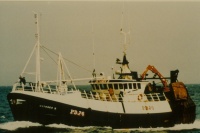Herring Home | Fishing for herring | Next
Herring fishing boats post World War II
After the Second World War drift net fishing continued to decline. In both World Wars the Navy used many fishing vessels, particularly steam boats. The government provided financial assistance to help renew the fishing fleet After World War II. The Admiralty built motor powered vessels for use during WWII, and afterwards, these were converted to fishing boats. There were also grants and loans for new construction. Most steam drifters were scrapped and new boats were built with diesel engines. These boats were more efficient, both mechanically and economically. The smaller engines also saved space in the hull. They were mainly wooden vessels with cruiser sterns. Boats continued to become bigger and more expensive, with a motor fishing boat in 1953 costing around £15,000. There was a trend towards fewer, larger boats and by 1965 the majority of boats were over 80ft in length.

After World War II, boats were built to be more adaptable. Many dual-purpose boats were built that could be used for seine netting for white fish and drift netting for herring. Few new boats exclusively for herring fishing were built.
In the late 1960s boats began to be built of steel, which was stronger than wood. At the same time, hydraulic winches and power blocks were also introduced to boats. These could haul larger nets. More and more powerful engines were also being used. In the 1970s gutting shelters began to be installed. This meant that much work could be carried out undercover. Nets were becoming larger and larger and were wholly synthetic.
There have also been great advances in hydraulic, electric and electronic equipment. All Scottish fishing boats are now motor powered. Engines are more powerful and hydraulic equipment, especially winches has been adopted. Generators driven off the engines provide electric power on all fishing boats.
All boats carry lots of electronic gear. There is ship to shore navigation. Previously fishermen depended on a compass and dead reckoning. The echosounder has been used the Second World War. It shows the depth of the seabed and can locate fish underwater. Before this, fishermen used a lead line to work out seabed depth. Radio receivers and transmitters are standard. Sonar was introduced in 1962. Decca navigation systems also became standard, but will probably be replaced by satellite navigation. Advanced weather instruments are also used. The list is endless!
Computers are also used. They monitor net sensors and regulate towing and hauling. Synthetic fibres have been developed. They give stronger and more durable ropes, lines and nets. There have also been great advances in conditions onboard with more space in the cabins and additions such as showers and televisions.